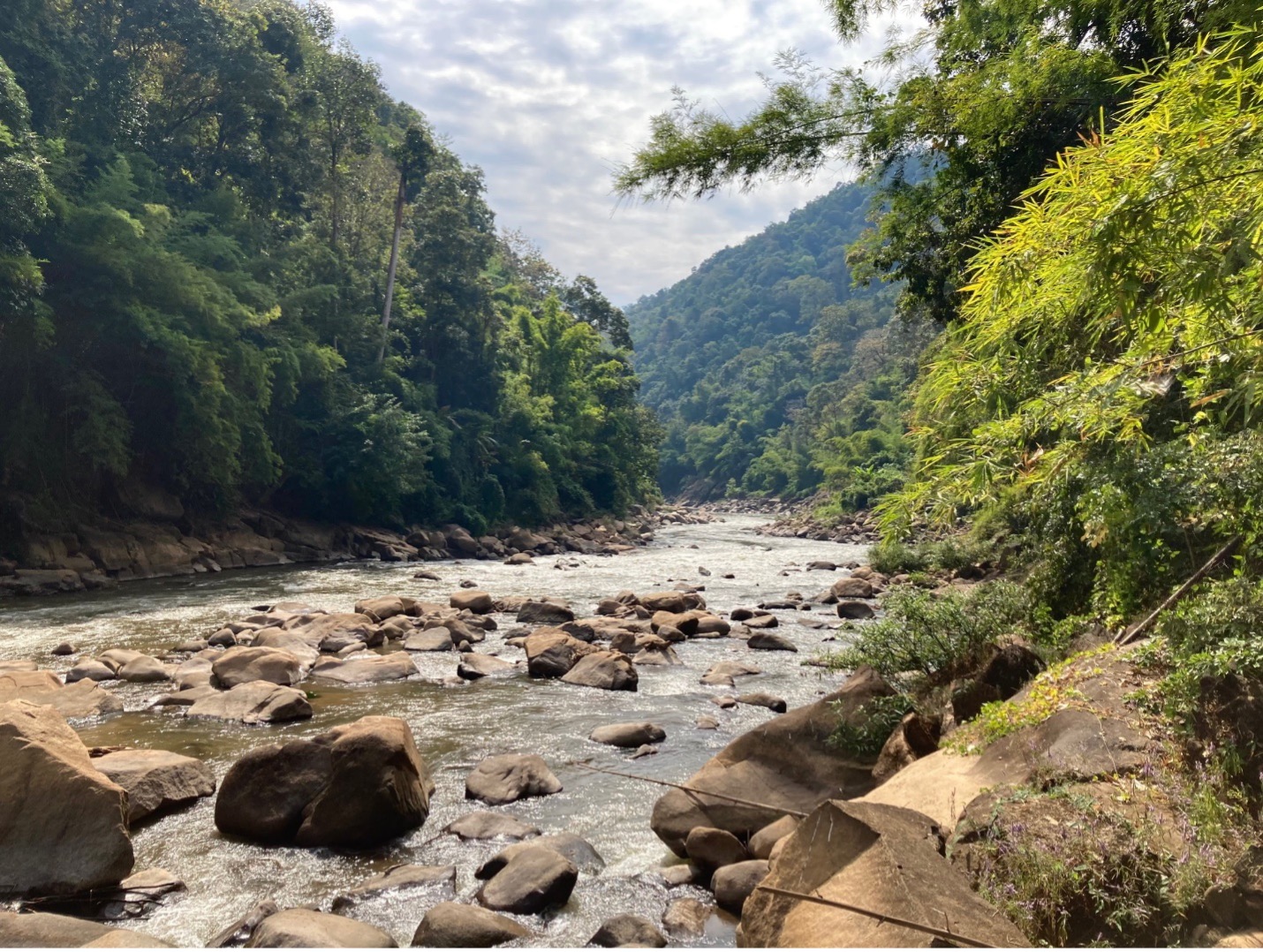
Zali Fung and Mueda Nawanat discuss the contested Yuam River Water Diversion Project.
A Thai translation is available here.
Around 2018, residents living along the Yuam River in Northwest Thailand near the Thai-Myanmar border heard about renewed Thai government plans to dam the river and divert water to Central Thailand. Affected residents and civil society are concerned that the proposed Yuam River Water Diversion Project (hereafter, Yuam diversion) would have widespread negative social and environmental impacts, and damage the livelihoods of several resource-dependent communities. The Yuam diversion has met increasing resistance from affected communities, who argue their voices have been overlooked in decision-making. As Paiboon Hengsuwan argues, while Salween borderland communities generally oppose large dams and diversions due to concerns over resource access and control, they are not necessarily ‘anti-development’ and seek to shape development ‘on their own terms’, as we show in the case of the Yuam diversion.
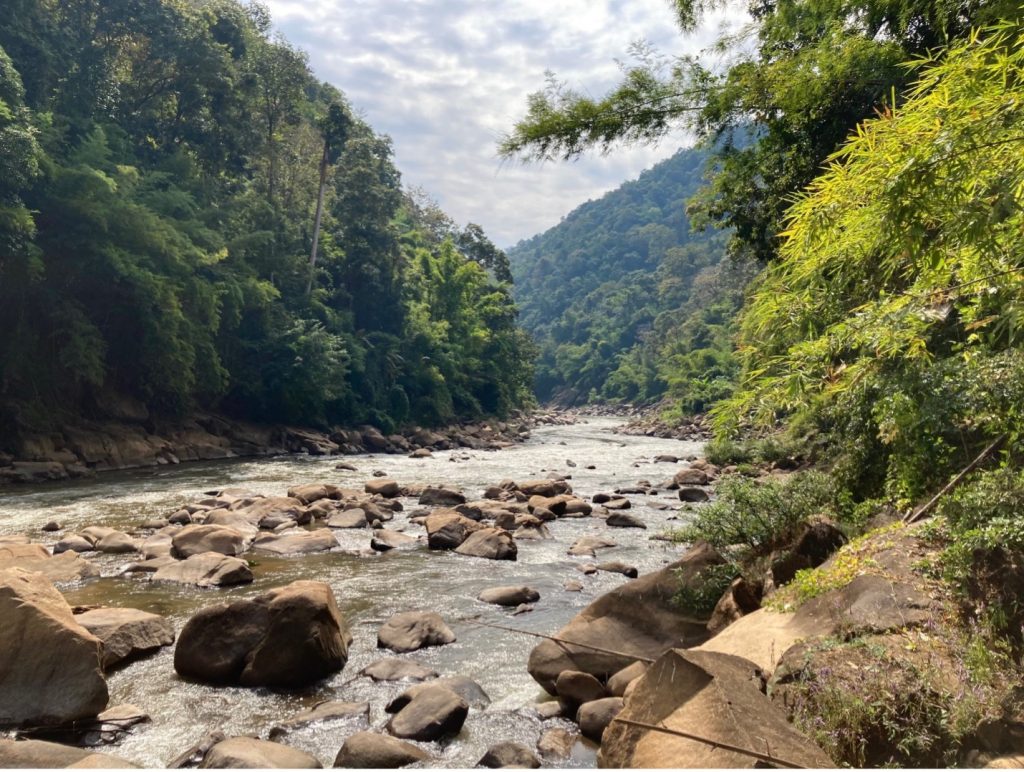
The transboundary Salween River commences in the Tibetan Plateau and runs through China and Myanmar, before forming the Thai-Myanmar border, and again flowing through Myanmar and into the Andaman Sea. The Yuam River flows from Northwest Thailand into the Salween River via the Moei River; both the Moei and Salween Rivers form stretches of the Thai-Myanmar border. The proposed Yuam dam site is around 14 kilometres from this border. Communities and civil society interviewees expressed concerns about the Yuam diversion’s cross-border implications, including for Karen spiritual and cultural values connected to the river, and for fish migrating between the Yuam and Salween Rivers. Despite this, downstream communities and relevant governing bodies in Myanmar have not been consulted.
Large hydropower dams and water diversions have been proposed for more than four decades in the Salween River Basin. This includes hydropower dams proposed on the Salween mainstem, including Weigyi and Dagwin Dams on the river-border, and Hatgyi Dam in Karen State, with the latter dam reaching the EIA stage. These dams would affect, and are resisted by, riverine communities across both sides of the border. This includes ethnic Karen communities that reside on both sides of the border, which pre-dates the demarcation of the border during British colonial rule of Myanmar.
Cross-border activism has been ongoing for decades in the Salween River Basin in response to proposed dams and diversions. For two decades, communities from Myanmar and Thailand, representing multiple ethnic groups and religions, have gathered along the Salween and its tributaries on the annual International Day of Action for Rivers (hereafter, March 14th Day) to celebrate and protect the river and natural environment, and oppose dams and diversions. However, since the February 2021 coup in Myanmar, violence and human rights abuses against civilians and activists have intensified, limiting such cross-border activism. Salween ‘borderland communities’ envision alternative forms of development to top-down authoritarian (hydro)development. For instance, the Salween Peace Park is a Karen-led initiative in Karen State and along Salween river-border that promotes conservation and community resource governance and control, including around the proposed Hatgyi Dam site.
The Thai government has investigated transboundary water diversions from the Salween River Basin to Central Thailand since 1979, including from the Salween mainstem and tributary rivers such as the Yuam. In interviews, many older residents and activists recall hearing about these dams and diversions when they were young, with some resisting previous iterations. This includes Mae Lama Luang Dam on the Yuam River, which was proposed in the 1990s but never constructed due the project’s environmental impacts and resistance by affected communities, many of whom are now resisting the Yuam diversion.
In 2016, the Thai government (re)examined several water diversion routes from the Salween River Basin to Bhumibol Dam, with the Yuam diversion emerging as the preferred option. The project is being developed by Thailand’s Royal Irrigation Department (RID). The Yuam diversion entails a 69.5-meter-high dam on the Yuam River, a water pumping station, and a 61-kilometer tunnel that would pass three Northern Thai provinces and several protected forest areas to divert water to Bhumibol Dam in the Chao Phraya River Basin. On 15 September 2021, this EIA was approved by Thailand’s National Environment Board (NEB). However, civil society and communities consider this EIA deeply flawed. While the project is estimated to cost 70 billion baht (US$2.1 billion) and take seven years to build, media outlets reported that a Chinese state-owned enterprise would build the project at around half the speed and cost, potentially as part of China’s Belt and Road Initiative. However, evidence of this is yet to be made publicly available.
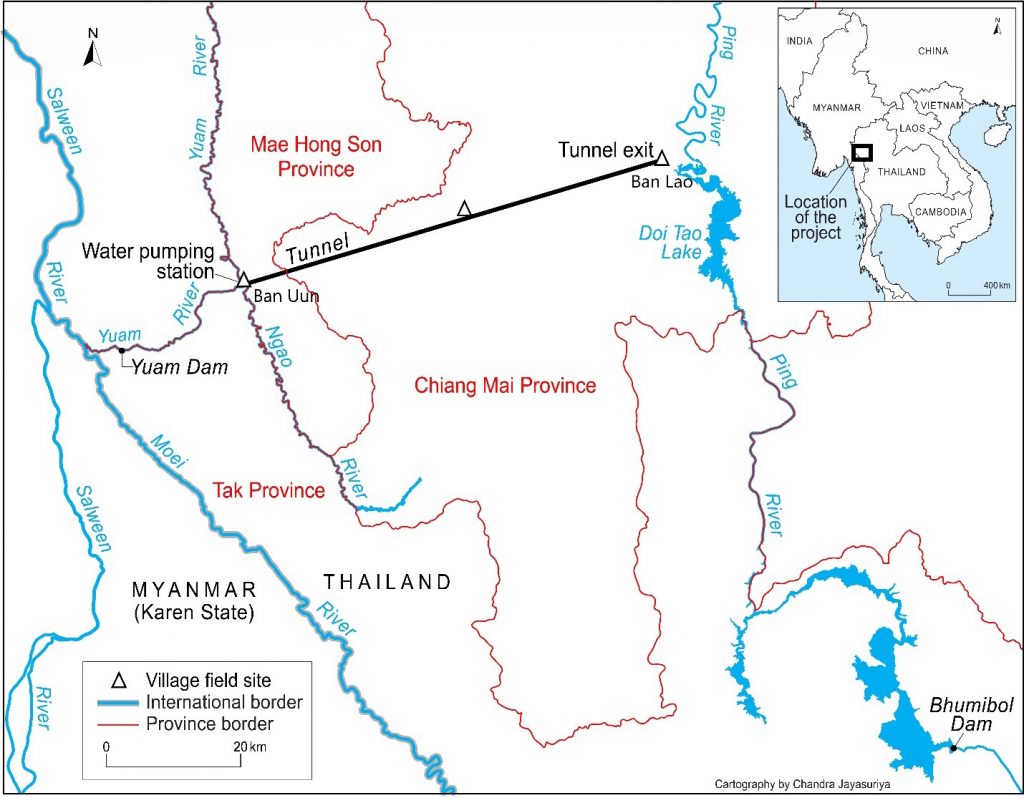
The research presented here (2021-ongoing) is based on in-depth interviews with affected community members, civil society actors – including activists, NGO employees and academics – and state actors, which were conducted as part of Zali’s PhD research. Mueda was a research assistant and English-Thai-Karen interpreter for this research. Mueda is a Karen activist, and has worked as an environmental and human rights defender in the Salween River Basin for decades. She was born as a stateless person near the proposed Yuam dam site, and has long advocated for citizenship rights for stateless peoples in Thailand.
Zali and Mueda’s research was undertaken in Ban Uun[1], a village located along the Yuam River and near the proposed dam site. Residents identify as Pwo Karen and Sgaw Karen, and rely on multiple seasonally-dependent livelihood strategies including collecting edible forest products (e.g., riverbank vegetables, mushrooms, konjac and more), fishing and labour migration. Many residents lack Thai citizenship and/or land titles, and many respondents reflected on how this limits their capacity to claim compensation and confidence to overtly challenge state-led development projects. Research was also conducted in Ban Lao, a Pwo Karen community located near the end of the tunnel. Residents’ livelihoods are based on longan farming and collecting forest products, and many do not have formal land titles. The community will be impacted by the dumping of soil and rock debris from tunnel construction on their farmlands and forests.
Affected residents are concerned about a range of social and environmental impacts that would damage resource-dependent livelihoods. This includes concerns that the project would exacerbate flooding during the rainy season, and cause deforestation, including in protected forest areas and spiritually-significant forests. The Yuam and Salween Rivers contain rich aquatic biodiversity, including many migratory fish species, and respondents were concerned that the dam would block fish migration, as one young Ban Uun resident explained: “If they block the river with a dam, those fish cannot migrate” (Interview, September 2021). Fish are essential to residents’ livelihoods, both for consumption, and as a source of protein and income. In addition, a fisheries expert at Maejo University, Chai, expressed concern that the diversion could transfer aquatic species from the Salween to the Chao Phraya Basin, which share only around six common fish species, with potentially damaging effects.
More broadly, there is evidence of dams’ negative impacts on fish and riverine livelihoods. For instance, the World Commission on Dams (WCD) reported a 60-80% decline in fish catch and reduced fish species directly upstream from Thailand’s Pak Mun Dam on the Mun River in the Mekong River Basin following the dam’s completion in 1994, although multiple anthropogenic factors may have contributed to this. This dam generated widespread resistance and shaped the politics of large dam construction in Thailand, the region and globally. In their 2000 report reviewing large dams globally, the WCD outlined the need for free, prior and informed consent (FPIC) for communities affected by dams and development. A lack of FPIC in the development process for the Yuam diversion is a key reason behind community and civil society opposition to the project.
Interviewees recounted several problems with the EIA process for the Yuam diversion, including a lack of meaningful public participation and FPIC. While numerous public hearings were conducted, participation was hindered in several ways. For instance, interviewees reported that public hearings were held in Central Thai language, and lacked translation into Karen languages, the primary languages of many affected residents. Many public hearings were held during the rainy season and/or under covid-19 restrictions, further hampering participation, particularly for remote communities. Significantly, residents and civil society were not given the opportunity to review, let alone contribute to, the EIA before it was approved by the NEB, directly going against the principles of FPIC. Civil society interviewees explained that the Office of Natural Resources and Environmental Policy and Planning (ONEP), the agency responsible for approving the EIA, requested more than 20,000 baht (US$600) to provide access to the EIA; they were only provided with a heavily redacted copy after the EIA was approved. Many residents reported that project proponents only promoted the project’s ‘benefits’ during public hearings, and residents felt their voices were not included in decision-making, as one older Ban Uun resident explained: “When local people raise our concerns, the government doesn’t provide a response … when people disagree with the project, the government doesn’t record it in the EIA” (Interview, September 2021).
Respondents provided several examples of incorrect information that was included the EIA, as one village leader, Chet, from Ban Uun explained: “I did not provide any support to the EIA, I did not discuss this in detail, we just spoke quickly [with the EIA team]. But the RID claims that we [Chet and his wife] support the project” (Interview, January 2022). Others felt that they were misrepresented by the EIA team. For instance, the headperson of Ban Uun told me that in a public hearing, the EIA team asked people who disagree with the project to raise their hands, and “they took a photo, and said ‘these people agree with the project’” (Interview, July 2021). Meanwhile, the headperson of Ban Lao felt the community has been “tricked” as journalists “misrepresented that the villagers and said they agree with the project” when they do not (Interview, February 2022). The EIA became satirically referred to as #EIALaab (#อีไอเอร้านลาบ) following an incident where the RID invited civil society members to lunch at a laab (meat salad) restaurant, during which photographs were taken and used as ‘evidence’ of public consultation. #EIALaab was used widely on social media, particularly by youth (Figure 3), and interviewees would often refer to ‘EIA laab’ with laughter.
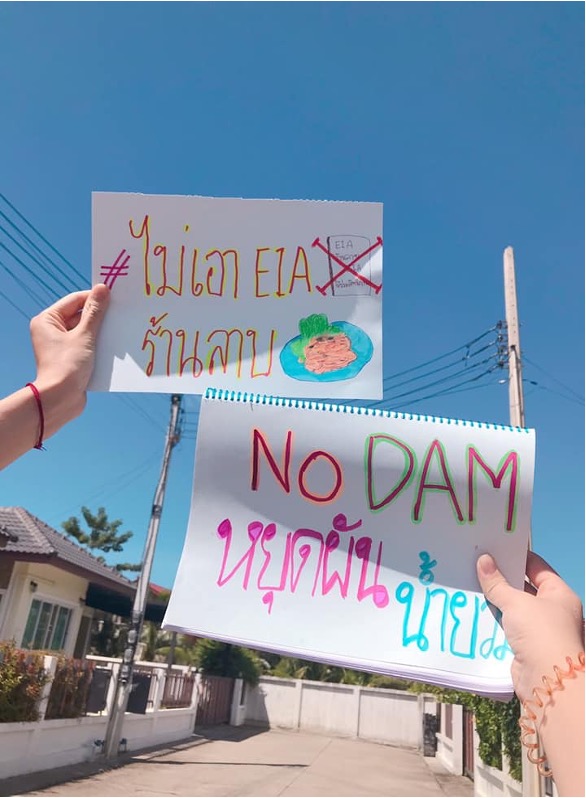
In contrast, a Thai politician who supports the project claimed that the EIA “is very meticulous. The EIA shows that this project is feasible, and does not damage anybody” (Interview, March 2022). RID officers also emphasised that the EIA was “in-depth” and conducted “according to the law” and included solutions to mitigate the project’s impacts (Interview, March 2022). However, as outlined above, many respondents disagree with these claims. The EIA has become a key site of contestation, illustrating how resistance is not only to the project itself but people’s capacity to ‘have a say’ in development.
All residents that we interviewed at both fieldsites disagree with the Yuam diversion. A few residents explained that they initially supported the project, because they believed government rhetoric that it would generate jobs and improve livelihoods, but changed their minds once they learned more about the project’s impacts. The youth are leading overt resistance to the Yuam diversion, including through protests and activities on March 14th. In Ban Uun, March 14th activities often include a buat pa (บวชป่า), or tree ordination ceremony, where residents, activists and visitors tie Buddhist monks’ orange robes around trees to bless and protect them, including from development. In recent years, this ceremony has been strategically held on a forested riverbank that would be damaged by the Yuam diversion. Several participants positioned buat pa as a way to oppose the Yuam diversion. Many older residents and activists have resisted previous proposals for dams and diversions, saw these projects and struggles as connected over time and generations.
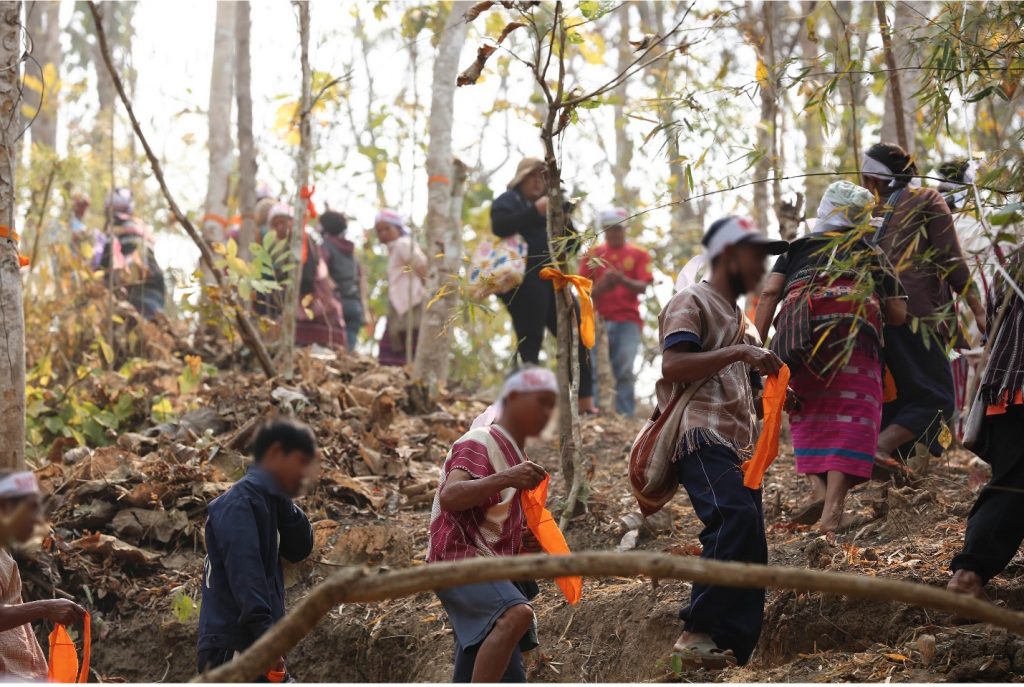
Salween communities oppose large dams and water diversions due to their negative ecological and livelihood impacts. As shown here, rather than being ‘anti-development’, these communities seek to shape and participate in development and articulate their own visions for water and natural resource governance. For instance, in a 2021 letter to ONEP, Yuam and Salween residents stated that: “We seek to be included by the state in decision-making to … preserve natural resources and to protect the Salween River Basin.” As one young woman from a border village along the Salween explained: “We do not oppose development, but it must be good development … we oppose those that create negative impacts” (Interview, March 2022).
Interviewees articulated alternative visions for river governance beyond hydrodevelopment. From a policy perspective, a water resources expert from Kasetsart University argued that rather than build the expensive Yuam diversion, the government should improve the efficiency of the water supply network, as “we have about 40% of water loss in the irrigation system due to inefficiency” (Interview, September 2021). Youth from affected communities questioned why the government would invest such large sums of money into a mega-project that would damage their resource-dependent livelihoods and futures, and suggested that this money should instead be invested into projects that would benefit their communities, including health, education and environmental protection.
Others highlighted the need to manage water from a more holistic perspective. An NGO employee who has worked on Mekong and Salween issues for decades highlighted the need to manage and “understand water in different dimensions” (Interview, May 2021), while Chai reflected that the RID only knows “how to block the water … they don’t understand about anything inside the water, or the people.” Rather than building damaging dams and diversions, residents and civil society actors envision alternative forms of resource governance that protects the environment and resource-dependent livelihoods, including the Salween Peace Park and community-managed riverine reserves along Salween tributaries in Thailand.
While there have been discussions[2] about how the coup may spur on controversial projects including Hatgyi Dam amid escalating conflict in the Salween River Basin, it is also affecting the capacity of communities and civil society to gather together and envision alternative forms of transboundary water governance. Despite this, these actors are persisting with efforts to protect the Salween. On March 14th 2023, residents and activists again gathered along the Salween and its tributaries to oppose the Yuam diversion and other mega-projects proposed in the Basin.
Zali Fung is a PhD candidate at the University of Melbourne. Her research examines the politics of dams and water diversions in the Salween River Basin.
Mueda Nawanat is a lawyer, human rights defender and Karen woman who grew up in the Salween River Basin.
Notes
Like This Article
September 26, 2024
June 18, 2024
April 26, 2023